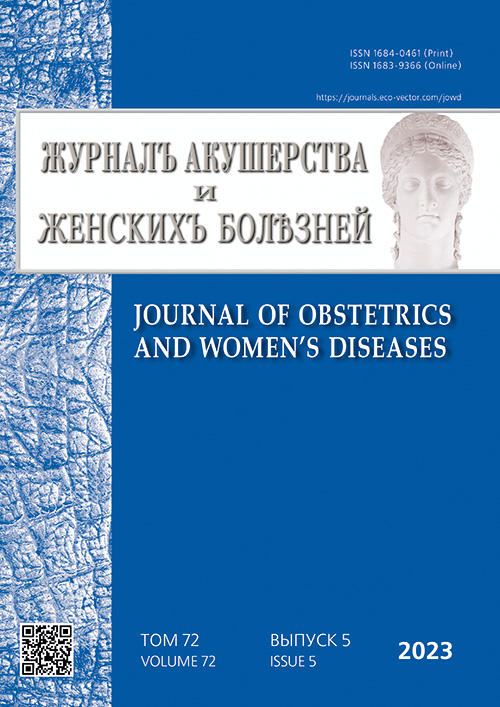Прогностическая шкала риска развития крупного плода
- Авторы: Баева И.Ю.1, Константинова О.Д.1
-
Учреждения:
- Оренбургский государственный медицинский университет
- Выпуск: Том 72, № 5 (2023)
- Страницы: 5-14
- Раздел: Оригинальные исследования
- Статья получена: 25.07.2023
- Статья одобрена: 15.09.2023
- Статья опубликована: 23.11.2023
- URL: https://journals.eco-vector.com/jowd/article/view/562983
- DOI: https://doi.org/10.17816/JOWD562983
- ID: 562983
Цитировать
Аннотация
Обоснование. Увеличение частоты встречаемости фетальной макросомии, высокий риск осложнений у матери и новорожденного, отсутствие алгоритма пренатального наблюдения при предполагаемой макросомии, особенно недиабетического генеза, вызывают необходимость поиска ранних прогностических маркеров развития крупного плода. Это позволит улучшить точность диагностики, оптимизировать акушерскую тактику ведения беременности и родов, а также разработать мероприятия, направленные на профилактику фетальной макросомии.
Цель исследования — разработать шкалу прогноза развития крупного плода на основе изучения прогностической ценности факторов и антифакторов риска макросомии.
Материалы и методы. Проведено одноцентровое проспективное когортное исследование на базе Оренбургского клинического перинатального центра. Включены 676 беременных крупным плодом (основная группа) и 600 беременных плодом со средней массой тела (контрольная группа), а также их новорожденные, наблюдение и исследование которых выполнено в период с 1 января 2015 г. по 1 января 2020 г.
Результаты. Крупные размеры плодов у женщин без существовавшего ранее и манифестных форм сахарного диабета в различной степени детерминированы как немодифицируемыми, так и модифицируемыми факторами риска, включающими ожирение, патологическую прибавку веса за беременность, особенно в III триместре, избыточное употребление углеводов, малую физическую активность.
Заключение. Расчет интегрированного влияния различных показателей на развитие крупного плода позволил установить ряд факторов и антифакторов в прогнозировании макросомии плода. В практическом акушерстве целесообразно использовать формализованные таблицы факторов риска развития крупного плода, разработанные на основе выявленных прогностически значимых коэффициентов.
Ключевые слова
Полный текст
Об авторах
Ирина Юрьевна Баева
Оренбургский государственный медицинский университет
Email: baeva37@mail.ru
ORCID iD: 0009-0000-4447-6762
SPIN-код: 5416-2362
канд. мед. наук
Россия, ОренбургОльга Дмитриевна Константинова
Оренбургский государственный медицинский университет
Автор, ответственный за переписку.
Email: const55@mail.ru
ORCID iD: 0000-0003-0369-0281
SPIN-код: 2067-5253
д-р мед. наук, профессор
Россия, ОренбургСписок литературы
- Одинокова В.А., Шмаков Р.Г., Чаговец В.В. Прогнозирование, профилактика и тактика ведения беременности и родоразрешения при фетальной макросомии // Акушерство и гинекология. 2018. № 1. С. 14–20. doi: 10.18565/aig.2018.1.14-20
- Геворкян Р.С. Макросомия плода: клинико-биохимические детерминанты. Особенности течения беременности, родов, перинатальные исходы: автореф. дис. ... канд. мед. наук. Челябинск, 2017 [дата обращения 12.08.2023]. Режим доступа: https://www.dissercat.com/content/makrosomiya-ploda-kliniko-biokhimicheskie-determinanty-osobennosti-techeniya-beremennosti
- Usta A., Usta C.S., Yildiz A., et al. Frequency of fetal macrosomia and the associated risk factors in pregnancies without gestational diabetes mellitus // Pan Afr. Med. J. 2017. Vol. 26. P. 62. doi: 10.11604/pamj.2017.26.62.11440
- Wang D., Hong Y, Zhu L., et al. Risk factors and outcomes macrosomia in China a multicentric survey based on birth data // J. Мatern. Fetal Neonatal Med. 2017. Vol. 30. No. 5. P. 623–627. doi: 10.1080/14767058.2016.1252746
- Beta J., Khan N., Khalil A., et al. Maternal and neonatal complications of fetal macrosomia: systematic review and meta-analysis // Ultrasound Obstet. Gynecol. 2019. Vol. 54. No. 3. P. 308–318. doi: 10.1002/uog.20279
- Scifres C.M. Short- and long-term outcomes associated with large for gestational age birth weight // Obstet. Gynecol. Clin. North Am. 2021. Vol. 48. No. 2. P. 325–337. doi: 10.1016/j.ogc.2021.02.005
- Тагунец Н.И. Прогнозирование и диагностика макросомии плода у беременных группы риска: автореф. дис. ... канд. мед. наук. Казань, 2014 [дата обращения: 12.08.2023]. Режим доступа: https://www.dissercat.com/content/prognozirovanie-i-diagnostika-makrosomii-ploda-u-beremennykh-gruppy-riska
- Черепнина А.Л., Панина О.Б., Олешкевич Л.Н. Ведение беременности и родов при крупном плоде // Вопросы гинекологии, акушерства и перинатологии. 2005. No. 1. С. 15–19.
- Salihu H.M., Dongarwar D., King L.M., et al. Phenotypes of fetal macrosomia and risk of stillbirth among term deliveries over the previous four decades // Birth. 2020. Vol. 47. No. 2. P. 202–210. doi: 10.1111/birt.12479
- Nguyen M.T., Ouzounian G.J. Evaluation and management of fetal macrosomia // Obstet. Gynecol. Clin. North Am. 2021. Vol. 48. No. 2. P. 387–399. doi: 10.1016/j.ogc.2021.02.008
- Wang C., Wei Y., Zhang X., et al. A randomized clinical trial of exercise during pregnancy to prevent gestational diabetes mellitus and improve pregnancy outcome in overweight and obese pregnant women // Am. J. Obstet. Gynecol. 2017. Vol. 216. No. 4. P. 340–351. doi: 10.1016/j.ajog.2017.01.037
- Barakat R., Pelaez M., Cordero Y., et al. Exercise during pregnancy protects against hypertension and macrosomia randomized clinical trial // Am. J. Obstet. Gynecol. 2016. Vol. 214. No. 5. P. 1–8. doi: 10.1016/j.ajog.2015.11.039
- Santos S., Voerman E., Amiano P., et al. Impact of maternal body mass index and gestational weight gain on pregnancy complications: an individual participant data meta-analysis of European. North American and Australian cohorts // BJOG. 2019. Vol. 126. No. 8. P. 984–995. doi: 10.1111/1471-0528.15661
- Zbucka-Kretowska M., Kuzmicki M., Telejko B., et al. First-trimester irisin and fetuin-A concentration in predicting macrosomia // J. Matern. Neonatal. Med. 2018. Vol. 32. No. 17. P. 2868–2873. doi: 10.1080/14767058.2018.1450859
Дополнительные файлы








